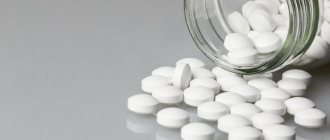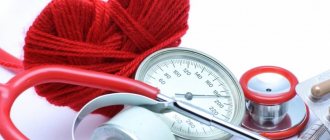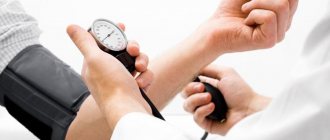At the initial stage of arterial hypertension, herbs that lower blood pressure are used. The effectiveness of natural remedies is revealed through their long-term and regular use, when a sufficient amount of active components accumulates in the body. Thanks to the medicinal properties of herbs, vascular tone is normalized, myocardial contractile activity is improved, and blood pressure is reduced. However, phytotherapeutic methods have their limitations, which must be taken into account during the treatment course. At what blood pressure levels can herbal medicine be used and what herbs are prescribed to eliminate hypertension?
Pharmacological properties of herbs for hypertension
The green part of the herbs contains a high concentration of active substances that have various effects on the vascular system. Thanks to these properties, a hypotensive effect is achieved, due to which the condition of a hypertensive patient is stabilized.
Hypertension develops as a result of the combined effects of provoking factors, such as: impaired blood vessel tone, mental stress, hormonal imbalance, and impaired renal function. Therefore, in order to normalize the tonometer values, you should choose herbs whose mechanism of action is aimed at various regulatory mechanisms.
Herbs that lower blood pressure, combined action:
- Sedative effect. A medicinal sedative helps with high blood pressure levels that arise against the background of emotional and mental stress. The soothing collection includes valerian, oregano, mint, motherwort, lemon balm, and wormwood.
- Regulation of vascular tone. The narrowing of the vascular lumen leads to an increase in blood pressure, so vasodilating plants are used to eliminate the spasm. These include: arnica, cudweed, shepherd's purse, astragalus, arnica, periwinkle.
- Diuretic action. Excess fluid in the body leads to excess load on the heart muscle, which provokes an increase in performance. To increase diuresis, knotweed, dill, horsetail, string, thyme, coltsfoot, and chicory are used.
- Anticoagulant action. To improve blood circulation, it is necessary to use biologically active components to thin the blood; they normalize the percentage of prothrombin, which is the prevention of atherosclerosis. These include meadow clover, hawthorn, valerian, meadowsweet, lemon balm, and sweet clover.
- Regulation of lipid metabolism. The formation of cholesterol plaques on the walls of the arteries disrupts the normal flow of blood, causing an increase in blood pressure. To prevent atherosclerosis, take primrose, dandelion, and alfalfa.
Complex herbal medicine is selected by the attending physician, taking into account the peculiarities of the course of the pathology. As the main treatment, it is used at the initial stage of arterial hypertension; in the presence of more severe forms, it is used as an addition to basic medications. To achieve a pharmacological effect, medicinal herbs are drunk for a long time.
What is blood pressure
As blood passes through the vessels, it puts pressure on their walls. Most often, blood pressure is measured in vessels called arteries. That's why pressure is called arterial pressure.
Blood pressure is assessed by two indicators - at the moments of maximum contraction and relaxation of the heart muscle. Normally, it corresponds to a certain physiological range of strength.
But when blood vessels narrow and the heart fails, the pressure becomes higher.
Hypertension, from Greek. hyper – over, tonia – tone, – excessive increase in blood pressure.
Causes of hypertension
- Psycho-emotional tension, stress;
- Hereditary predisposition;
- Sedentary lifestyle;
- Chronic diseases (diabetes mellitus, pyelonephritis, etc.);
- Excess body weight;
- Bad habits.
High blood pressure is lowered with the help of medications that have hypotensive (hypo - low, tens - tone) properties. Some medicinal plants can have this effect.
Hypotensive effect
Herbs for high blood pressure, when taken regularly, can increase the period of remission and reduce the risk of developing complications of hypertension. Regular use of medicines based on medicinal plants can lower blood pressure by 10-15 units. However, it is permissible to use phytotherapeutic agents at values not exceeding 150/90 mm. Hg Art. For severe hypertension, folk remedies are combined with antihypertensive drugs.
After a course of treatment, hypertensive patients experience a significant improvement in their condition. The tone of the vascular system is restored, the flow of oxygen to brain cells improves, excess intracellular fluid is removed, and hemodynamic blood parameters are normalized. Stabilizing the functioning of the body ensures the prevention of stroke and heart attack, which are the most dangerous complications of the disease.
Treatment of hypertension with the help of plants occurs due to the normalization of the following processes:
- reduce the excitability of the nervous system;
- slow down the heart rate;
- metabolic processes are restored;
- cleansing the body of toxic breakdown products;
- expansion of the lumen of blood vessels;
- strengthening the smooth muscles of the arteries;
- removal of excess fluid.
The main principle of herbal medicine is the elimination of provoking factors, as well as the prevention of recurrent attacks.
No ads 1
Classification of hypertension
Based on the causes of occurrence, the following types of hypertension are distinguished:
- primary (idiopathic) - the exact causes of its occurrence are not clear;
- symptomatic – occurs against the background of other diseases or when taking certain medications.
According to the nature of the course, hypertension is:
- benign (develops slowly, progresses gradually);
- malignant (develops quickly, has a severe course, usually has an endocrine etiology).
By degree of pressure increase:
- mild hypertension (pressure no higher than 140/90, drug therapy is usually not required);
- moderate hypertension (pressure up to 180/110);
- severe hypertension (malignant form of the disease).
The benign form of hypertension has three stages of development:
First stage (preclinical). The pressure is not higher than 150/100, after proper rest it decreases on its own. The patient may experience minor sleep disturbances and moderate headaches.
Second stage . There is hypertrophy of the left ventricle and narrowing of the arteries. The pressure rises frequently and remains stable. Indicators of 160-180/100-110 can be observed even at rest.
Third stage . There is dissection of the aortic walls, hemorrhages in the fundus, and angina pectoris develops. At this stage, the risk of strokes, heart attacks, and vision loss is extremely high.
A special form of the disease is hypertensive crisis. It is characterized by a sharp increase in pressure to critical levels. The patient feels very bad, he has severe headaches, nausea, vomiting, and increased intracranial pressure. This condition can persist for up to a day.
If a person has a hypertensive crisis, they should provide first aid and immediately call an ambulance.
Features of preparing folk remedies
During the preparation process, it is necessary to preserve beneficial substances that have a healing effect. The severity of the clinical effect depends on the correctness of the method of manufacturing herbal medicines. It is recommended to adhere to the following recommendations:
- For the manufacture of products, dried raw materials are used, collected during a favorable period of time with further observance of storage rules.
- Before brewing the raw material, it must be crushed in order to increase the concentration of active components in the finished medicine. To do this, use a mortar or knife, chop the stems, roots, leaves, and keep the seeds in their original form.
- If it is necessary to use a mixture of plants, it is recommended to grind each type separately and then mix in equal proportions.
- To prepare decoctions and infusions, glass or ceramic dishes are used. The use of metal containers is contraindicated in order to prevent the interaction of metal with medicinal substances.
- The finished product should be filtered through several layers of gauze.
- The duration of storage of the herbal collection should not exceed two years.
- The volume of prepared products should be small, since the active substances disintegrate quickly.
Important! When preparing folk remedies, it is necessary to adhere to the indicated doses and treatment regimen, since an overdose can lead to the development of side effects.
Prevention of hypertension
Prevention of the disease includes compliance with the following recommendations:
- rejection of bad habits;
- proper nutrition, weight control, prevention of obesity;
- pressure control;
- daily walks in the fresh air;
- hardening the body, strengthening the immune system;
- timely treatment of somatic diseases;
- regular rehabilitation of foci of chronic infection in the body (caries, chronic tonsillitis and a number of others);
- physical education classes, other physical activity;
- Regular preventive examinations will help identify hypertension at an early stage, when it is still asymptomatic, which will greatly facilitate treatment and improve the prognosis.
Potent herbal remedies
Herbs for lowering blood pressure, which have a strong effect, can normalize blood pressure in a short time. Tinctures, infusions, and decoctions based on them are indicated at 170/100 mm. Hg Art.
Sweet clover
The healing properties of sweet clover are due to its composition; it contains a high concentration of vitamin C, coumarin, tannins, carotene, and tocopherol. In folk medicine, sweet clover is used to lower blood pressure, as it has a diuretic and anti-sclerotic effect. The plant helps remove excess fluid and prevents the formation of blood clots.
The biologically active substances of sweet clover are part of Cardiofit, a combined medication with moderate hypotensive, cardiotonic and antiarrhythmic effects.
Recipe for a decoction based on sweet clover for hypertension:
Do raspberries increase or decrease blood pressure?
- 2 tbsp. l. pour 400 ml of hot water into the sweet clover;
- cook over low heat for 10 minutes;
- stand for 40 minutes;
- filter;
- drink 1 tsp. 3 times a day.
The decoction restores peripheral blood circulation, reduces nervous excitability and prevents the formation of blood clots.
No ads 2
Adonis
Widely used for diseases of the cardiac and vascular systems, it contains flavonoids, cardiac glycosides, saponins, and alkaloids. Due to its diuretic and vasodilating effects, adonis is used for high blood pressure. The therapeutic effect consists of normalizing blood pressure, restoring heart rhythm, increasing stroke volume and reducing central nervous system excitability. Herbal infusions, including adonis, remove intracellular fluid, which helps eliminate swelling of the legs due to hypertension.
It is recommended to treat hypertension with Adonis using an infusion:
- 1 tsp. crushed adonis pour 250 ml of boiling water;
- the product should be infused in a warm place for 3-4 hours;
- take 1 tsp. 3 times a day.
With long-term therapy with Adonis, the amount of herb is reduced by 2 times.
Marsh dry grass
Contains the alkaloid gnafalin, which has a vasodilating effect on peripheral vessels. Sushenitsa restores hemodynamics, while reducing tonometer values. Medicines based on it are indicated at the initial stage of the disease, since the plant acts as a complete drug.
Reception is recommended to prevent complications of hypertension, especially stroke
Cider infusion for severe hypertension:
- 30 gr. pour 200 ml of boiling water over the dried raw materials;
- Close the container and leave for 30 minutes;
- strain the infusion;
- drink 2 tbsp before meals. l. 4 times a day.
The prepared infusion should be stored in the refrigerator for no more than 2 days.
Treatment of hypertension (classical medicine)
The course of therapy is selected by the attending physician individually for each patient, taking into account the degree of hypertension, the presence of complications, and the individual characteristics of the body.
Treatment is usually medicinal and includes the following groups of drugs:
- thiazide diuretics - reduce fluid levels, which leads to a decrease in blood pressure;
- sartans;
- calcium antagonists;
- beta-blockers - normalize the rhythm of the heart;
- alpha-adrenergic receptor blockers - dilate peripheral blood vessels.
Patients should lead a calm lifestyle, avoid stress and emotional overload. In addition, you must follow a special diet.
Plants with moderate hypotensive properties
Anti-pressure herbs with a moderate hypotensive effect are recommended for slight increases in blood pressure. These include:
- Plantain. The high content of phytoncides and tannins causes a hypotensive effect. Taking plant-based products eliminates heart palpitations, reduces swelling, and reduces the load on the myocardium.
- Spiraea. Restores blood circulation, strengthens the walls of blood vessels, removes intracellular fluid.
- Oregano. Has a beneficial effect on the functioning of the cardiac and vascular system. Helps eliminate vascular spasm, reduces psycho-emotional stress.
- Air. Used for both therapeutic and prophylactic purposes. The action is aimed at reducing the excitability of the nervous system and expanding the arterial lumen.
What substances do our blood vessels need?
For the vascular system to function normally, the following substances must be supplied to the body:
- Rutin is from the group of vitamins P, it strengthens capillary walls and has an indirect effect on lowering blood pressure. By lowering blood pressure, the risk of vascular structure ruptures is reduced.
- Vitamin C has a positive effect on smooth muscles, making them more permeable. The tissue of the vascular walls becomes elastic.
- Vitamin E, an antioxidant, has a slowing effect on cell destruction. Due to long-term intake of vitamin E, the fragility of blood vessels is significantly reduced.
- Vitamins B and K work as stimulants of intercellular metabolism occurring in the walls of blood vessels. Due to this, the likelihood of a heart attack is reduced, since the heart muscle receives the substances necessary for its normal functioning.
- Iron and potassium keep blood vessels elastic; these elements are responsible for transporting oxygen to the walls of capillaries.
Blood purification is a necessary procedure that directly affects the structure of blood vessels and their fragility. The purer the blood, the stronger the blood channels, the less atherosclerotic plaques form inside them. “Harmful” cholesterol and sodium compounds make capillary walls brittle, increasing the likelihood of vascular wall rupture.
Sedative properties of herbs
Plants that have a sedative effect are indicated for patients who are subject to frequent stress, which causes fluctuations in blood pressure. They help reduce the negative impact of stress. Calming herbs are also taken as antidepressants, as they can eliminate neurogenic factors.
Chamomile relieves nervous tension and can be taken as a tea throughout the day.
List of herbs with sedative properties:
- St. John's wort. Systematic use allows you to eliminate anxiety and depressive states.
- Peppermint. Reduces the excitability of the nervous system, improves sleep. Used in the form of tea, it is prepared from 1 tsp. dry mint leaves, which are poured with 200 ml of boiling water. Consume 25-30 minutes after brewing.
- Thyme. Pronounced sedative and hypnotic effect. Prepare the infusion: 1 tbsp. l. thyme, pour 200 ml of boiling water and leave for 10-15 minutes. The drug is taken in the afternoon or before bedtime.
- Valerian. The most effective sedative, effectively eliminates anxiety, excitability, restlessness. Decoctions are consumed against the background of stress.
Anticoagulant properties of plants
For women and men who have a tendency to form blood clots, it is recommended to use medications that thin the blood. Folk remedies prevent the progression of hypertension, reduce blood viscosity, improving its circulation through the vessels.
Herbs that normalize hemodynamic blood parameters:
- sweet clover;
- nettle;
- tansy;
- calendula.
Thinning herbal mixture for hypertension:
- Mix 2 tbsp. l. wormwood, arnica, meadowsweet, sweet clover.
- Pour the mixture with 500 ml of boiling water.
- Leave for 8-9 hours.
- Take 3 times a day, 150 ml before meals.
- Therapeutic course – 4 weeks.
No ads 3
Why do you need to clean vessels?
Blood vessels lose strength over time and become brittle and vulnerable. The causes of such negative phenomena are age-related changes, previous injuries, poor diet, alcohol and smoking. Under the influence of these factors, the vessels stretch, thin out and become vulnerable. If vascular diseases are accompanied by high blood pressure, there is a danger of rupture of blood arteries.
Poor vascular condition can be determined by the following symptoms:
- periodic pressure surges;
- dizziness and weakness;
- fainting and rapid heartbeat;
- increased body temperature;
- darkening of the eyes;
- cold extremities.
Particularly dangerous is the rupture of the blood channels of the brain, which in most cases leads to a stroke and death. With timely diagnosis, the risks of hypertension and heart attack can be significantly reduced.
Antispasmodic properties
To normalize blood pressure, herbal infusions are used to eliminate vascular spasm resulting from atherosclerotic disease. Their action is aimed at reducing the level of bad cholesterol, which is deposited on the walls of blood vessels. Treatment is carried out using decoctions and infusions, and alcohol tincture is contraindicated.
Among hypertensive patients, the following collection has proven itself to reduce blood pressure:
- Mix 1:1 motherwort and crushed valerian root.
- Simmer in a water bath for 30 minutes.
- Leave in a dark place for 5 days.
- Drink 1 glass 3 times a day.
- Therapeutic course – 30 days.
Herbal medicines to protect arteries should be taken in a course of 1 month, after which they take a break.
From increased intracranial pressure
Intracranial high pressure is caused by blood stagnation, impaired outflow of cerebrospinal fluid, hemorrhages or tumors.
Characteristic signs of increased intracranial pressure are:
- Morning headaches that worsen in the evening;
- Heaviness in the head;
- Disruption of the vegetative-vascular system. Sweating, pressure surges, near fainting;
- Meteor dependence;
- Lying down aggravates headaches.
- For intracranial hypertension, the use of herbs complements the main therapy. To treat this condition, herbal preparations are used. They may include diuretic plants for the drainage of excess fluid, anti-inflammatory plants for stopping inflammatory processes and other agents, depending on the cause of the disease and symptoms.
To treat this condition, herbal preparations are used.
Intracranial pressure collection:
Ingredients, one teaspoon each:
- valerian or motherwort;
- horsetail or hops;
- sage;
- mint;
- St. John's wort.
- Place in a bowl and pour 400 ml of boiling water.
- Cook in a water bath for half an hour.
- Strain.
- Store in a glass jar in the refrigerator for no more than 5 days.
- Take a few sips for severe headaches or fatigue.
Diuretic effect
Hypertension can be treated with diuretic herbs only if the pathological process has become chronic. Diuretic plants should be used carefully, since in parallel with the removal of excess fluid, they wash away microelements and vitamins necessary for the full functioning of the body.
Herbal remedies that reveal diuretic properties:
- Dill (dill decoction increases diuresis and dilates arterial walls).
- Bearberry (the use of the plant in its pure form is not recommended; it should be included in the antihypertensive preparation as a diuretic).
- Sage (stimulates the activity of the adrenal glands, restores blood circulation).
Important! The selection of diuretic folk remedies should be carried out by a specialist who also establishes the required dose and proportions of additional components. Natural medicines have some contraindications and side effects, but their mechanism of action is milder compared to synthetic drugs.
Contraindications
Before starting treatment, you must familiarize yourself with the list of contraindications and possible adverse reactions. This will avoid adverse consequences. It is also advisable to consult a doctor. Only a specialist can adequately assess the general state of health and the advisability of prescribing herbal medicine.
If we consider the list of contraindications as a whole (for most plants), it will look like this:
- Individual hypersensitivity to individual components of plant materials. Allergies occur to any plant and are usually expressed in the form of local irritation of the skin and mucous membranes, urticaria. However, it is possible that symptoms of anaphylactic shock or Quincke's edema may appear.
- Arterial hypotension (including orthostatic). An additional decrease in blood pressure can lead to depression of consciousness (stupor, stupor, coma) and disorders of the blood supply to organs.
- Peptic ulcer of the stomach and duodenum. Acute infectious diseases of the gastrointestinal tract. Most plants reduce platelet aggregation and coagulation and promote “breakthrough of the bicarbonate barrier” of the gastric mucosa. As a result, life-threatening bleeding may develop.
- Pathologies of the vascular bed with a high risk of the formation of thrombotic masses (varicose veins of the lower extremities, thromboangiitis obliterans, hemorrhoids).
- Any deviations in hemostasis that occur as a result of hypocoagulation (leukemia, thrombophilia).
- Diseases of the liver and kidneys with symptoms of functional failure. Slow elimination of plant components from the body is fraught with intoxication.
- Arrhythmias (AV block, bundle branch block, sinus bradycardia, pacemaker displacement).
When using drugs together with other medications that have an antihypertensive effect, consultation with a specialist is necessary.
Selection of individual collection
Herbal collections for hypertension can be compiled independently, taking into account the characteristics of the course of the disease and the severity of symptoms. So, in case of frequent attacks, it is necessary to include potent and sedative plants in the collection, supplementing them with herbs that have an antispasmodic and vasodilating effect.
In most cases, a hypertensive attack is accompanied by a headache; calendula and hops are used to eliminate it, and lemon balm and valerian will reduce the feeling of anxiety.
Having chosen the main antihypertensive plant (clover, motherwort), other herbs are added to it on a decreasing basis, affecting the accompanying manifestations of the disease. Today, you can buy a ready-made antihypertensive preparation at the pharmacy, which is brewed like regular tea. This remedy should be taken according to the instructions.
Symptoms of hypertension
The main clinical signs of increased blood pressure are:
- Headache .
It can occur at any time, but most often at night or immediately after waking up. The intensity of pain depends on the stage and course of hypertension. The pain is often localized in the occipital region, but can also affect other parts of the head. Patients describe this condition as “a feeling that the head is being squeezed by a hoop.” Pain may intensify when coughing, sneezing, laughing, or turning the head sharply. Long-lasting pain leads to increased irritability of the patient and sensitivity to external stimuli (bright light, noise). - Shortness of breath . It occurs initially only after physical exertion, then, as hypertension progresses, at rest.
- Swelling of the legs due to hypertension . May be one of the symptoms of heart failure, kidney disease, or occur when taking certain medications.
- Visual impairment . Quite often, when the pressure increases, the patient’s vision becomes blurred, and “spots” flash before the eyes. This clinical picture is associated with impaired blood circulation in the retina. If the pathological process in the retina has gone too far, then a significant decrease in visual acuity and even blindness is possible.
Five herb tincture
A popular recipe for hypertension includes five types of medicinal herbs with different mechanisms of action. To prepare the tincture, you need to mix 100 ml of tincture of valerian, peony, motherwort, eucalyptus in equal proportions and add 25 ml of mint infusion. Next, add 10 clove inflorescences to the mixture and leave for 15 days in a dark room. Mixing the tincture is contraindicated. Take 3 times a day, 15 g. 15 minutes before meals. The course of treatment is 30 days, then take a break for 10 days.










